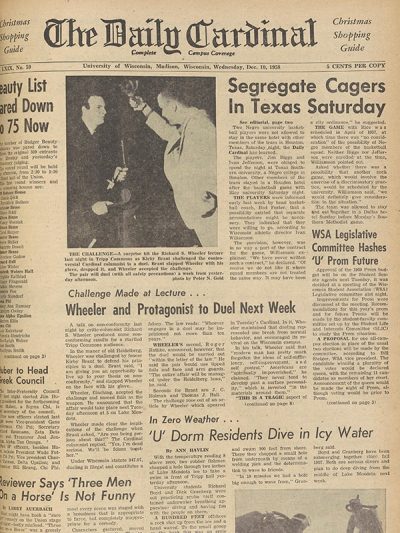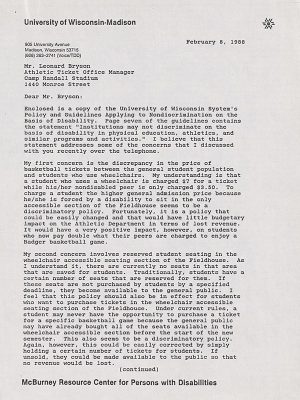Athletics
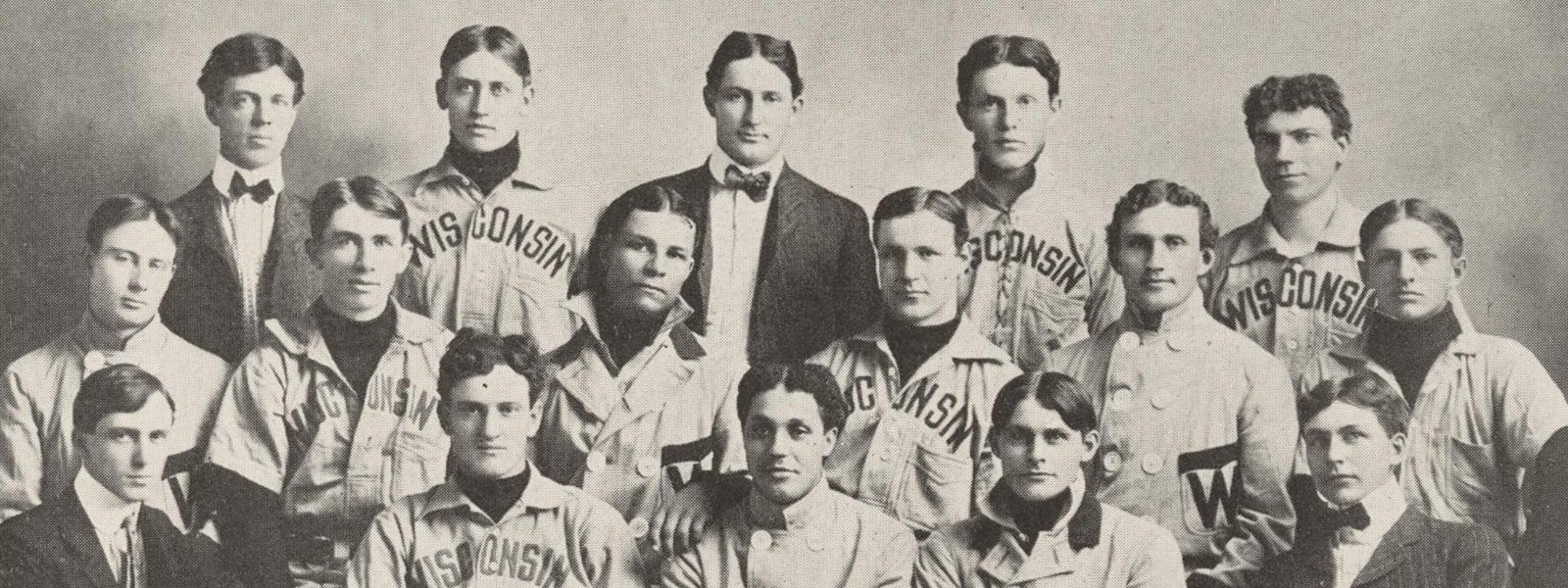
UW–Madison is famous for its varsity athletic teams. Many students, alumni, and community members alike revel in the celebratory atmosphere of game days and rally together to support the Badgers. Yet, not all feel the welcoming atmosphere or community spirit. Throughout history, marginalized populations have been excluded from participating in, coaching, or even attending athletic events at UW–Madison.
These cases of exclusion are juxtaposed against powerful stories of resistance, perseverance, and activism that challenged college athletics to be more equitable. Some athletes, coaches, and fans at UW–Madison have shown a dedication to fighting for equality and equal representation on and off the field. They have used their voice to advocate for desegregation, equal compensation, and an increase in diversity recruitment efforts. Many of these efforts continue today.
The First Athletes
For more than 100 years, college athletes from marginalized communities have played a central role in the success of Wisconsin Badger athletics. Those who were the first to join integrated teams at UW–Madison are rightfully celebrated. Being the first was not easy. These athletes were subjected to hostile and demeaning treatment from their teammates, received unequal coaching and scholarship opportunities, and were at times forced to use segregated accommodations when they competed out of state.
1900 Julian Ware and Adelbert Matthews
Julian Ware and Adelbert Matthews became the first African American varsity college athletes at UW–Madison when they joined the baseball team in spring 1900. Ware also became the first African American to captain a Big Ten team when his peers elected him to that position in 1902.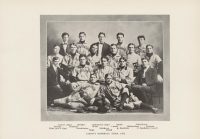
1901 George Poage
George Poage had a lifetime of firsts: the first African American to graduate high school in La Crosse, Wisconsin (1899); the first African American track athlete at the UW (1901); and the first African American to win an Olympic medal (1904). At UW–Madison, he excelled at running and history and worked as a trainer for the football team to support his graduate education. After his Olympic fame in the 1904 summer games, he lived a quiet life working as a postal clerk in Chicago until retiring in the 1950s.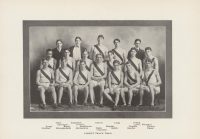
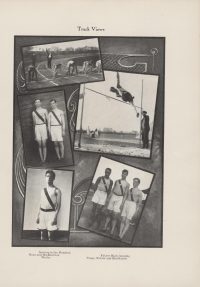
1903 Gordon Lewis
Raised in the only Jewish family in the small town of Highland, Wisconsin, Gordon Lewis is considered one of the first Jewish athletes at UW–Madison. From 1903 to 1905 he was a star pitcher and outfielder for the baseball team. After spending five years in the national minor league, Lewis returned to UW–Madison in 1911 to work as a physical education instructor and baseball coach.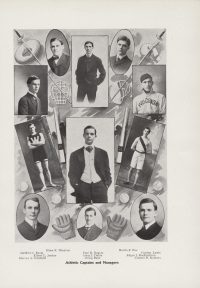
1904 Thomas “Ted” St. Germaine
Thomas “Ted” St. Germaine is one of the most prominent early Native athletes at UW–Madison. St. Germaine was admitted to the Law School in 1904 and played on the football and water polo teams, but he left without graduating. He later graduated from Yale Law School, where he also played football. He eventually returned to the Midwest to coach football and work in law, and he became the first Native American in Wisconsin to be admitted to the bar.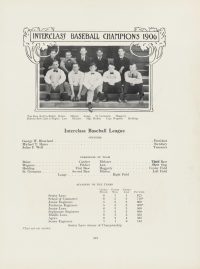
1945 Akio Konoshima
Akio Konoshima arrived at UW–Madison in fall 1944 after being detained in a Japanese American incarceration camp during WWII. In 1945, Konoshima became one of the first Japanese American athletes at the UW when he earned a spot on the varsity boxing team. By the end of his first season, Konoshima held the best record on the team—only one loss in seven bouts. Even the loss was highly contested as the deciding referee had stated he was not going to “let” a Japanese boxer win. UW coach Tom Kenneally told the press that Konoshima had been “robbed.” The following year, team members elected Konoshima as their honorary captain. After graduating, Konoshima would go on to serve in the Korean War and work as a professional journalist in Japan, London, and the U.S.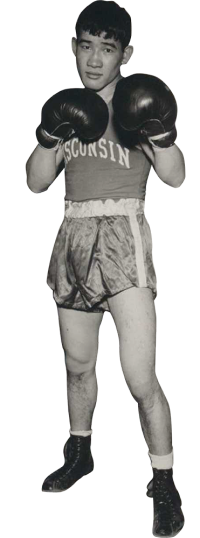
The Color Line in College Athletics
“The real question is, Do we mean what we say? Do we actually mean that Negroes, for instance, have equal rights with those of other races, and that those rights are so dear to us as Americans that we will make some sacrifice to protect them?”
Throughout the early 20th century, Black college athletes were excluded from participating in select sporting events. This practice was colloquially referred to as the “color line.” Routinely in this era, all-white segregated Southern colleges and universities refused to compete against Black athletes or integrated teams, and many Northern schools acquiesced to these demands and voluntarily benched Black athletes.
In 1939, UW–Madison track coach Tom Jones was formally notified by the University of Missouri that an upcoming track meet was racially segregated. Jones quietly told Ed Smith, a Black man on the team, he could not compete. After the news broke in the Daily Cardinal, the UW faculty senate passed a resolution condemning the color line in college athletics and urging the university to not compete at segregated events. Jones asked the track team (without Smith present) to vote. The members unanimously decided not to attend the meet if Smith was not welcome. The team subsequently withdrew. However, university administrators took no official action and some athletic color lines remained on campus, particularly in basketball.
“There exists a ‘gentlemen’s agreement’ among the coaches of basketball in the Big Ten that they will not use Negro players no matter how good they are. Is this not an opportune moment to right our own house? Speak out, Mr. Foster!”
Breaking the Color Line
Despite welcoming the participation of Black athletes in many sports, the Big Ten conference—of which the UW is a member—informally banned the participation of Black basketball players until the 1940s. Members of the campus community had protested the Big Ten and UW basketball’s racial policies for many years, and Wisconsin’s lingering basketball color line became increasingly controversial by the 1950s. The men’s basketball head coach, Bud Foster, was repeatedly highlighted in newspaper articles for keeping Black players off the team. Finally, in 1958, Jim Biggs and Ivan Jefferson became the first Black players to join the UW–Madison men’s basketball team. UW–Madison was the second to last team in the Big Ten to integrate its basketball team. The acceptance of Biggs and Jefferson to the team was not the end to forced racial segregation. In December 1958, ahead of a game at Rice University, the rest of the team stayed at a hotel while Biggs and Jefferson “were obliged” to stay in the dorms at Texas Southern University, a historically Black university. University administrators defended their solution, stating that Biggs and Jefferson were not enrolled 18 months prior when the game was scheduled and at that time there was “no consideration of the possibility” that the basketball team might one day include Black players. Upon realizing the week before that lodging for the Rice game would be a problem, Foster addressed the situation with the team, which decided to proceed with the event. Before the end of 1958, the UW athletics department decided that “Wisconsin teams will no longer play at schools where team members are segregated or discriminated against.” By the time the policy was announced, the university’s inaction had already created a buzz of opinion articles in the Daily Cardinal. The articles discussed the North vs. South mentality that allowed Wisconsinites to avoid their own role in discrimination.
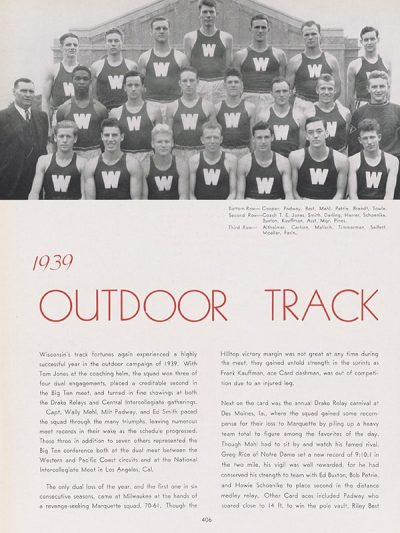
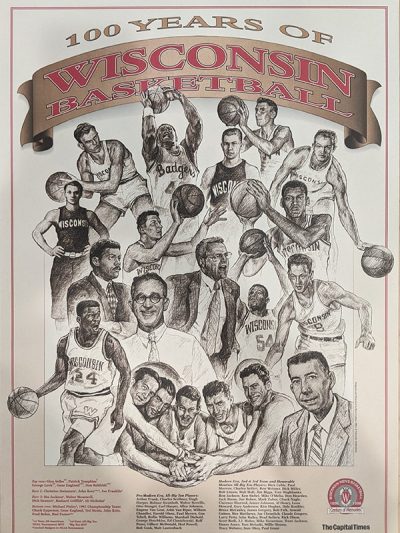
First Athletic Staff
“We understand their battle cry for a more diverse campus. The lack of diversity is also represented within our department. You must do better. If not now, when?”
Although often celebrated for their successes, the first athletic coaches and staff from marginalized groups at UW–Madison reported being disrespected by peers. At times, they were disproportionately blamed for the failures of their teams. Throughout the history of UW–Madison, coaches and staff of color have struggled to build a strong sense of community within the primarily white athletics department. This problem persists today. In 2020, a group of 13 Black coaches and staff stood in silent protest to call out the lack of diversity in their department and demand change.
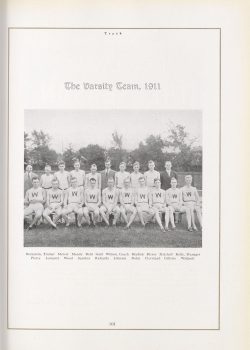
1906 – Ike Bernstein
From 1906 to 1912 Ike Bernstein served as the trainer for the men’s basketball, track, baseball, and football teams at UW–Madison. Bernstein is believed to be the first Jewish athletic staff member on campus. In 1911 he was blamed for causing the football team to lose to archrival University of Chicago. Coaches claimed he had not adequately conditioned the players. Though he disagreed, he decided to leave UW–Madison in 1912.
1966 – Lewis Henry “Les” Ritcherson
Lewis Henry “Les” Ritcherson caught the attention of Badger football administrators after leading several segregated Texas high school teams to state titles. The university had been under pressure from community members to integrate the coaching staff. After being courted by UW administrators, Ritcherson consented to come north only after Head Coach Milt Bruhn and UW President Fred Harvey Harrington offered “assurance[s] that the university was strongly committed to seeing that Ritcherson received the support he needed to succeed as a full-fledged member of the coaching staff.” Ritcherson subsequently negotiated for an unusual five-year guaranteed contract. He was hired in 1966, becoming the second Black football coach in the Big Ten and the first Black assistant coach of any sport at UW–Madison. The Capital Times reported the hiring of a “Negro coach” on its front page. Others on the coaching staff were reportedly displeased with Ritcherson’s contract, and rumors spread that his employment at the UW as a coach was only due to a “package deal” with his son’s position as quarterback on the football team. Yet, Ritcherson had an impressive record of leading championship teams prior to coming to the UW. The rumors surrounding his hire and the unusual nature of his contract created tension between Ritcherson and the rest of the coaching staff. That tension persisted, and the racial discrimination Ritcherson faced as the only Black coach on the staff caused him to feel even more isolated during his time with the UW football team.
Ritcherson enjoyed coaching and connected with athletes. Yet, he struggled with the hostile environment created by the predominantly white coaching staff. This made it difficult for Ritcherson to find community and make positive changes both for his players and the culture of UW–Madison athletics more broadly.
Ritcherson later became one of the first African American academic administrators at the UW when he accepted the job as assistant to the chancellor for affirmative action in 1970. Until his retirement in the 1980s, Ritcherson was an important voice for equal opportunity and diversity throughout the UW System.
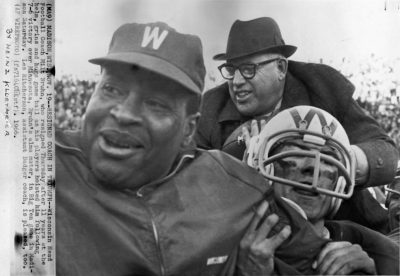
“Coaching at the University of Wisconsin was nothing like I envisioned. In fact, I liked coaching. I did until I coached at the University of Wisconsin. … I never envisioned the humiliations and non-comradeship I endured as assistant football coach. [They were] the most miserable days of my entire life. I never experienced anything that … demeaning and unprofessional … as I endured as a football coach at the University of Wisconsin … It’s difficult for me to say, but it’s the truth.”
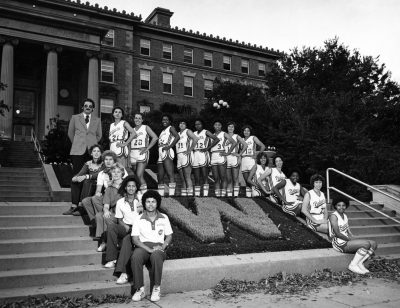
1976 – Edwina Qualls
“And when you feel you’re being discriminated against, you file a complaint.”
In 1976, Edwina Qualls became the first African American coach for women’s basketball in the Big Ten. For more than a decade, Qualls and Kit Saunders, the UW’s director of women’s athletics, were the two caretakers of women’s athletics at UW–Madison. This was due, in part, to the hasty construction of the department following the passage of Title IX in 1972. Title IX is a federal civil rights law that prohibits sex-based discrimination in any school that receives federal funding. Setting up a new athletics department for women, with less funding and institutional support, was an arduous task made more difficult by the constant prioritization of men’s sports.
In 1978, after only two years at the university, Qualls filed a Title IX complaint against UW–Madison, alleging sex discrimination. In particular, Qualls said, women were discriminated against in the athletics department. Director of Athletics Elroy Hirsch argued that Qualls was “nitpicking” her complaints. Qualls’s last seasons at UW–Madison were mired in controversy. Newspaper coverage called attention to her team’s record and her coaching strategy. She believed she was more harshly critiqued than other coaches at the UW because of her race. UW Athletics declined to renew Qualls’s contract in 1986.
Activism and Athletics
“It’s always the right time to do the right thing and the right thing to do was to try to help to make this better.”
Many UW–Madison athletes have participated in the larger social movements on campus. But taking a stand did not come without consequences. During the Vietnam War protests in 1967, the captain of the football team, Kim Wood, stood between a group of protestors and police in hopes of getting the police to stop tear gassing and attacking students with long clubs. Instead, he took the brunt of the attack. During the 1969 Black Student Strike, Black football players joined the act in solidarity. Harvey Clay, a Black football player, lost his athletic scholarship as his grades suffered from trying to balance participating in the multiweek protest and keeping up with his schoolwork and athletic training. Without the financial support of the scholarship, he was forced to drop out.
Boycott of the Annual Football Banquet
Two days before Thanksgiving in 1968, 18 Black football players, including all of those on the varsity squad, boycotted the annual football banquet. This was the culmination of several years of increasing tension between Black players and athletic administrators. The players presented a list of grievances, including a shortage of counseling services, limiting the on-field positions of Black players, discriminatory rules for activities off the field, and a lack of five-year scholarship programs. The players also called attention to differences in how white and Black players were coached. They alleged Coach John Coatta had mandated that Black players not date white women, and that white players were given easy trucking jobs for Coatta’s father-in-law, while Black players worked more arduous jobs at the Oscar Mayer meat-packing plant.
Following the boycott of the banquet, white linebacker Ken Criter blamed the Black players for the team’s poor record that season: “There are guys that should have been kicked off the team but were not because they are Black. They are the ones who discriminated against us.” In the fallout from the boycott, Assistant Coach Gene Felker quit, citing the administration’s failure to stop protests on campus. He said that Black players committed “treason” against the coaching staff and claimed that white coaches were not given opportunities to succeed. In response, the UW Athletic Board met with both Black and white players, as well as coaches, and brought in a psychiatrist to assess and work toward improving team morale.
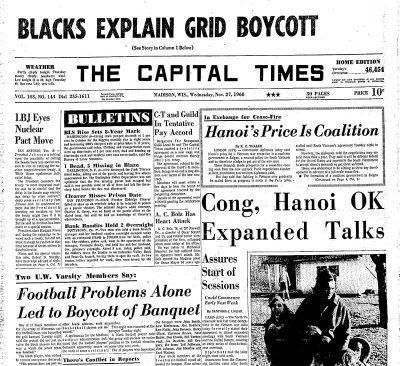
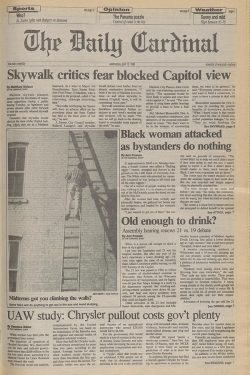
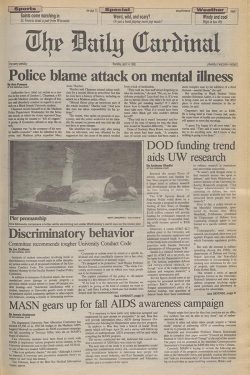
Black Athlete Attacked
In spring 1988, a Black female athlete was violently attacked by a white man in broad daylight on campus. The student was called racial slurs as she was beaten, strangled, and thrown to the ground. Police and administrators argued that the attacker’s mental illness played an outsized role in the attack, while the community argued that it was impossible to ignore the racism embedded in the incident. Students and fellow athletes rallied to her support, hosting multiple protests. Student pieces in the Daily Cardinal called attention to the precarious safety of students of color on campus and the university’s inability to protect students.
Are Black Women Safe at the University of Wisconsin–Madison?
The “Obama Noose” Incident
“Many people believe that student athletes of color are immune to the racial injustices that affect other students of color on campus. However, our experiences are not shielded by the ‘W’ we wear on our chest, our experiences are one in the same. We are loved during competition, but then subjected to racial discrimination in our everyday lives too.”
In fall 2016, during a home football game between Wisconsin and Nebraska, two fans were photographed in costumes. One was wearing a prison jumpsuit, alternating between masks of Barack Obama and Hillary Clinton, with a noose tied loosely around his neck. The other wore a Donald Trump mask, holding the rope of the noose. The incident garnered national attention. The university’s immediate response—to ask the fans to remove the noose but allow them to remain at the game—was heavily criticized by professors, students, alumni, and community leaders. University and athletics department administrators argued the fans were protected under the First Amendment. The most vocal condemnation came from UW athletes, led by basketball senior Nigel Hayes. Chancellor Rebecca Blank apologized for how the university initially responded and revoked the season tickets of the fans involved. The university committed to providing better security at the stadium.
Recent Activism
College athletes continue to push for change on and off campus. In 2016, basketball player Nigel Hayes went viral online when he posed with a sign that stated, “Broke College Athlete. Anything Helps.” During and after his time at UW–Madison, he continued to lobby for National Collegiate Athletic Association (NCAA) athletes to be compensated for their labor. In 2018, basketball player Marsha Howard, a Black woman, remained seated during the national anthem in solidarity with NFL quarterback Colin Kaepernick and other professional athletes protesting police brutality, drawing the ire of Senator Chuck Grassley (R-IA). In 2020, Black athletes posed a list of demands including adding a black W crest to all uniforms to show support for Black students.
Accessing Athletics
Participating in the atmosphere of athletic events is a highlight of campus life at UW–Madison. Yet, these spaces are inaccessible for many people with disabilities. Throughout the 1970s and 1980s, those with disabilities at UW–Madison struggled to access campus athletic events. In the 1970s, students from the Handicapped Student Association noted there were no places for those in wheelchairs to attend basketball games at the Field House. In response, UW Athletics removed two rows of bleachers to create seating for wheelchair users. In 1980, Professor James Graaskamp reported that seating at the Coliseum for hockey games had been insensitively converted from wheelchair spaces into box-seats for the able-bodied. In 1988, McBurney Disability Resource Center assistant director B. A. Scheuers identified a price discrepancy in basketball tickets that required wheelchair users to spend nearly twice as much to attend games. While some accessibility concerns were addressed, others were ignored. These incidents highlight some of the challenges disabled members of the UW–Madison community encountered when trying to participate in the spirit of campus athletics.
Who is a Badger?
The Badger has long been the symbol of the state of Wisconsin. The term refers to the early lead miners. After invading Ho-Chunk lands in the 1820s, many miners lived in their diggings, much like badgers live in underground setts. Since 1889, Badgers has been UW–Madison’s nickname. The beloved Bucky Badger mascot was created by students in 1949. He has been a campus icon ever since.
A symbol of not only UW Athletics but the campus community at large, calling oneself a Badger is a sign of ownership. Part of the college experience is about finding community and about belonging to something bigger than yourself. This happens in a variety of ways—through classes and student groups, social activities and athletic events, campus spaces and the city of Madison. But who gets to belong? Who feels comfortable calling themselves a Badger?
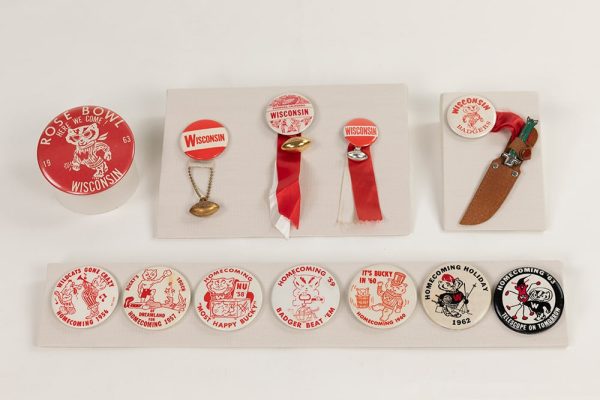
Bucky has had many looks over the years. Displayed here are early concept drawings commissioned by the Wisconsin Alumni Association. One such early concept depicts Bucky dressed in a costume indicative of Native American cultural dress. This sample harkens back to the problematic history of “playing Indian” at UW–Madison.
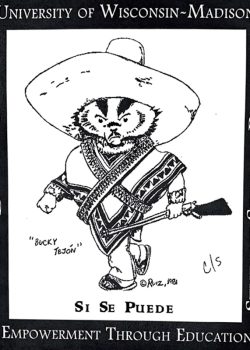
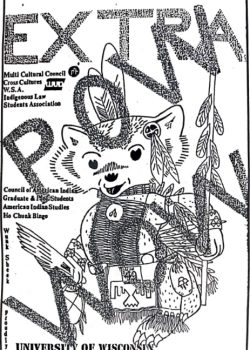
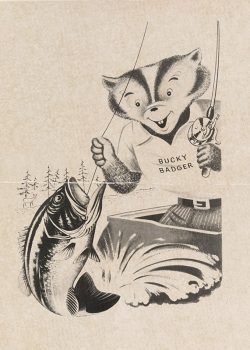
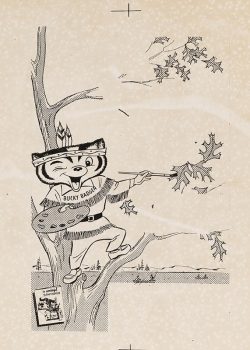
Sources
- “Wisconsin’s Black History: Our Timeline.” UW–Madison Athletics. Accessed December 9, 2021.
- Bond, Gregory. “Julian Viviane Ware.” UW–Madison Athletics. Accessed December 16, 2021,
- Bond, Gregory. “Celebrating UW’s African-American Olympians: George Poage.” UW–Madison Athletics, Last modified February 5, 2012.
- Pollack, Jonathan Z.S. Wisconsin, the New Home of the Jew 150 Years of Jewish Life at the University of Wisconsin–Madison (PDF). Self-published, 2019.
- “Who were the first students of color?” Ask Flamingle (blog), Wisconsin Foundation and Alumni Association.
- “Ossowski Breaks Nose; Veterans Retain Titles.” Daily Cardinal (Madison, WI), Feb. 6, 1945, UW–Madison Archives, UW–Madison Libraries.
- Konoshima, Akio. “Interview with Akio Konoshima Part 1 of 2.” Interview by Terry Shima. 22 March 2004, in Bethesda, Maryland. Digital recording. Veterans History Project, American Folklife Center, Library of Congress, Washington D.C.
- “Boxers Nip Lions; Seahawks Fight Here Friday Night.” Daily Cardinal (Madison, WI), Feb. 20, 1945, UW–Madison Archives, UW–Madison Libraries.
- Bond, Gregory. “Jim Crow at Play: Race, Manliness, and the Color Line in American Sports, 1876–1916.” Ph.D. dissertation, University of Wisconsin–Madison, 2008.
- Bond, Gregory. “Ed Smith.” UW–Madison Athletics. Accessed December 16, 2021.
- Bond, Gregory “1939 Track Article.” UW–Madison Athletics. Accessed December 20, 2021.
- “Celebrating Black History.” UW–Athletics. Last modified January 01, 2014.
- Bond, Gregory. “Jim Biggs and Ivan Jefferson.” UW–Madison Athletics. Accessed December 20, 2021.
- “Segregate Cagers in Texas Saturday.” Daily Cardinal (Madison, WI), Dec. 10, 1958, UW–Madison Archives, UW–Madison Libraries.
- “Senate May Consider Bias on Houston Basketball Trip.” Daily Cardinal (Madison, WI), December 16, 1958, UW–Madison Archives, UW–Madison Libraries.
- Stiehm, Judy. Letter to the editor. Daily Cardinal (Madison, WI), Dec. 12, 1958, UW–Madison Archives, UW–Madison Libraries.
- Executive Committee of the Wisconsin Socialist Club. Letter to the editor. Daily Cardinal (Madison, WI), Dec. 18, 1958, UW–Madison Archives, UW–Madison Libraries.
- “Black coaches support call for greater diversity on the UW–Madison campus.” WKOW, August 31, 2020.
- Bond, Gregory. “Remembering UW’s First Black Football Coach.” Diversity, Equity & Inclusion (blog), Last modified December 16, 2019.
- Levitan, Stuart D., Madison in The Sixties. Madison: Wisconsin Historical Society Press, 2018.
- Lenz, R.R. “Complaint filed against UW claims sports discrimination.” Wisconsin State Journal, Oct. 11, 1978.
- Ring, Agnes. “UW Women Aim for Better Year.” Wisconsin State Journal, Dec. 3, 1976.
- For more information on Title IX: “Title IX Manual.” United States Department of Justice.
- Hibner, Perry. “Players Happy Qualls Ordeal is Over.” Wisconsin State Journal, June 6 1986.
- Hibner, Perry. “Appeal is Denied, Qualls is Out.” Wisconsin State Journal, June 6 1986.
- McCall, Molly. “Former student recounts political activism that once defined UW.” Badger Herald, May 3, 2012.
- Clay, Harvey. Interview by Edward Frame. 24 March 2020. Oral History Project, UW–Madison Archives.
- “Football Problems Alone led to Boycott of Banquet.” Capital Times (Madison, WI), Nov. 27, 1968.
- Butler, Tom. “Boycott is Directed at Coaches.” Wisconsin State Journal, Nov. 28, 1968.
- Greene, Bob. “Race Problem Hurt Badger Grid Team.” Capital Times (Madison, WI), Nov. 27, 1968.
- “Felker Resigns as U.W. Football Aide.” Wisconsin State Journal, Dec. 6, 1968.
- Ritcherson, Lewis Sr. “Oral History Interview: Lewis Ritcherson, Sr.” Interview by Gregory Bond. 19 May 2017. OH #1227, Oral History Project, UW–Madison Archives.
- Powers, Ann. “Black woman attacked as bystanders do nothing.” Daily Cardinal (Madison, WI), Apr. 13, 1988, UW–Madison Archives, UW–Madison Libraries.
- Powers, Ann. “Police blame attack on mental illness.” Daily Cardinal (Madison, WI), Apr. 14, 1988, UW–Madison Archives, UW–Madison Libraries.
- Shadid, Anthony. “Group says racism rally requires White role.” Daily Cardinal (Madison, WI), Apr. 18, 1988, UW–Madison Archives, UW–Madison Libraries.
- Euseary, Angelica. “Are Black Women Safe at the University of Wisconsin–Madison?” UW–Madison Public History Project (blog), Last modified July 20, 2020.
- Bieler, Des. “Fan in Trump mask holds noose around fan in Obama mask at Wisconsin game.” Washington Post, Oct. 29, 2016.
- “Badger Athletes Demand Change, Call Noose Incident ‘Punch in the Face.’” Madison365, November 7, 2016.
- Speckhard, Lisa. “Nigel Hayes, UW student athletes tweet call to action in light of Camp Randall noose incident.” (Madison, WI) Nov. 8, 2016.
- Temple, Jesse. “Wisconsin Players cite campus racial inequalities, demand change.” ESPN, Last modified November 7, 2016.
- Tomsyck, Teymour. “Blank apologizes for handling of Camp Randall noose incident.” Badger Herald (Madison, WI), Nov. 8, 2016,
- Kessler, Martin. “How Two Wisconsin Basketball Players Decided To Take On The NCAA.” NCAA Show, Last modified October 13, 2017.
- Ryan, Shannon. “’I’m going to live in my truth’: Why Marsha Howard sits alone on the bench while her teammates stand for the national anthem.” Chicago Tribune, Feb. 12, 2019.
- Rittenberg, Adam. “Wisconsin uniforms to feature black ‘W’ on crest.” ESPN, July 15, 2020.
- Jacobs, Irene D. “Campus Concern: The Disabled Student.” Wisconsin Alumnus, March 5, 1973, UW–Madison Archives, UW–Madison Libraries.
- James A. Graaskamp to Elroy L. Hirsch, Blair Mathews and McBurney Resource Center, 24 October 1981, Box 8, Folder 6, Memoranda, McBurney Disability Resource Center Records (1965–2009), Chancellor’s Committee for Disabled Persons, 1980–81, UW–Madison Archives, UW–Madison Libraries.
- B.A. Scheuers letter to Leonard Bryson, February 8, 1988, Box 4, Folder 27, McBurney Disability Resource Center Records (1965–2009), Accessibility Projects, UW–Madison Archives, UW–Libraries.
- Jurado, Alex. “Why is Wisconsin the Badger State — and do actual badgers live here?” Milwaukee Journal Sentinel, Nov. 9, 2021.
- “Bucky Badger – A Historical Look Back.” UW–Athletics
In conclusion
“True resistance begins with people confronting pain … and wanting to do something to change it.”
As we fearlessly sift and winnow through the university’s past, many hard truths emerge. We also find hope, and the ever-present possibility of change for the better. The university has changed in many ways across its history, often because members of the campus community have demanded it.
We believe that reckoning with our history can lead us to a better future, and that unless we acknowledge and learn from our past, we cannot move forward together. The future is not yet written. What happens next is up to us.
The UW–Madison Public History Project was made possible with support from the Office of the Chancellor using private funds.
